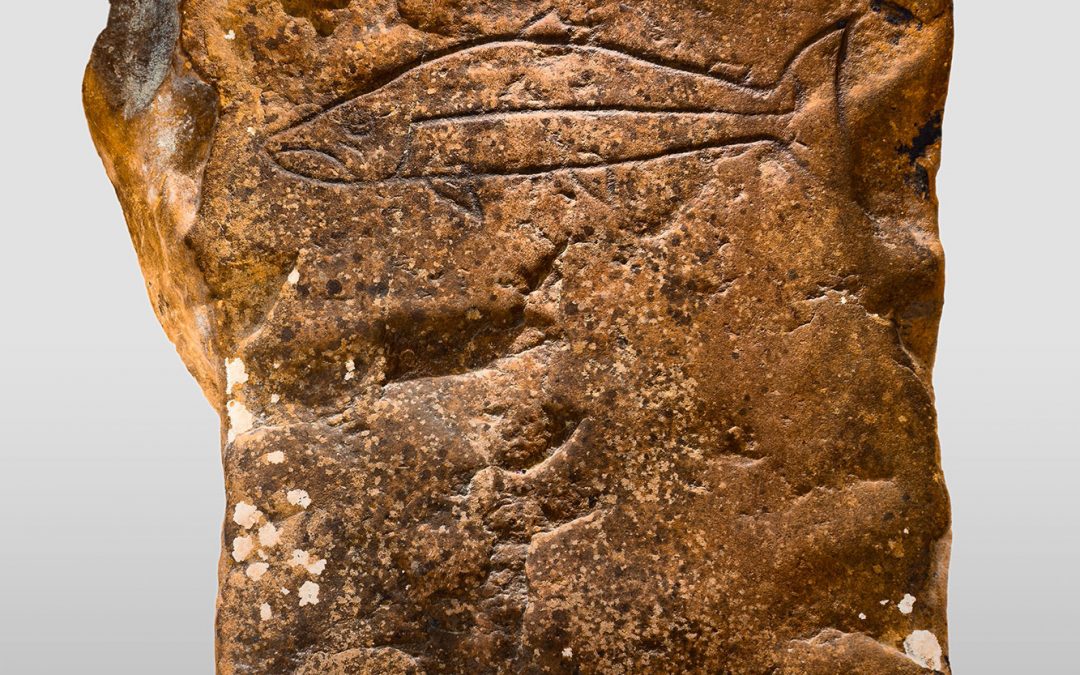One of Gairloch Museum’s star objects is its Pictish symbol stone – beautifully displayed in the recess of one of the blast doors of the bunker. But where and when was this rare object discovered and how did it end up in the Museum? This blog tells the tale of the stone so far and documents its travels around the village before it ended up in its current spot.
Pictish stones are common in the north and east of Scotland, but very rarely found on the west coast. The discoveries of the symbol stone in Gairloch and the one in nearby Poolewe were significant as they show evidence of Picts where they were not supposed to be. We know these symbol stones were manufactured in this area, as they are made of local sandstone.
One of the many mysteries surrounding the Gairloch stone is that it may have been found twice. It is known to have been discovered in 1949, while the foundations were being dug for the Swedish houses at the bottom of the Gairloch Glebe.
When it was discovered, the Gairloch Pictish stone formed part of a cist burial – a grave pit constructed of slabs of stone. The cist measured 175cm long and 40cm wide. Inside it were the remains of a female skeleton, stretched out on its back. Canmore identifies the spot as being now marked by the doorstep of number 2 Faolin. These human remains are now part of the collection of National Museums Scotland.
The Country Road Surveyor at the time was W.G. Bannerman. He reportedly made extensive notes on the finding of the Pictish stone. It is not clear what happened to these notes but some of the information in them is reported in an article in the Proceedings of the Society of Antiquaries (Stevenson, 1951) . One of the things W.G. Bannerman noted was that he believed a Pictish stone had been found on the same site seventy years before. Was this the same stone? Had it been quietly buried again in 1880 before being rediscovered when the Faoilin was being constructed? This is the most likely explanation since it would be a great coincidence if two Pictish stones were found on the same site.
John Henry Dixon’s book on the history of Gairloch, published in 1886, identifies a number of ancient artefacts found in the Gairloch area, but curiously makes no mention of a Pictish stone. If one had been found around 1880, surely he would have mentioned it. Nor are there any newspaper reports that mention the find during that period.
In the early 1890s when the foundations were being dug for the new Free Presbyterian Church next to the Faolin, three further prehistoric burials were reputedly found. It seems that the north shore of Loch Gairloch, in Achtercairn and Strath, had been used as a burial site by our prehistoric ancestors.
After the Pictish stone was rediscovered in 1949, it was moved to Flowerdale House. It was the custom for archaeological finds to be given to the landowners, the Mackenzies of Gairloch. The Pictish stone was briefly used as a doorstep for one of the outhouses at Flowerdale. But it did not stay there long.
By 1951 the stone had been moved into the porch of the Church of Scotland. It stayed there for a few years but it must have been in the way as a decision was taken to build it into the wall of the new Gairloch burial ground. Maps from the time show its position in the southern wall of the burial ground.
In 1977 Gairloch Heritage Museum was opened by a group of local heritage enthusiasts who identified the need to preserve some of the material culture of the area that was becoming endangered. A letter from the Ancient Monuments Officer of the time states that the Gairloch Pictish stone was in good condition, apart from being dirty and covered with algae and lichen.
When the Pictish stone had been found, it was broken. Sheriff Morton Murdoch, who later acquired the stone for the museum, believed that it had split during its recovery and that the top part might still be in the ground underneath the house at Faolin. Meanwhile, the bottom part took pride of place among the displays at Gairloch Heritage Museum.
In 2019 Gairloch Heritage Museum moved home, to a former nuclear bunker, and became known simply as Gairloch Museum. It was necessary to move the Pictish stone again. This was not an easy task due to its size and weight. It took five men and two women to get it into its new position. The weight of the stone had to be calculated to ensure that the new mount being built to support it could take the strain.
The Pictish symbol stone has taken pride of place among the new displays. It now sits in a recess where a doorway used to be. The museum label that explains its significance is mounted on the door itself – a heavy blast door which is one of the original features of the building.
The Gairloch Pictish stone is reckoned to be around 1500 years old. It has had many homes in its lifetime. Was it created specifically for the cist burial in which it was later found? Or did it have a more prominent position in the landscape before that? As the stone is now part of the collection of the accredited Gairloch museum, its preservation into the future is now ensured. Who knows what additional information will be revealed about it in the future?

